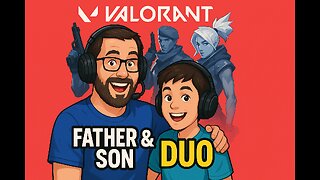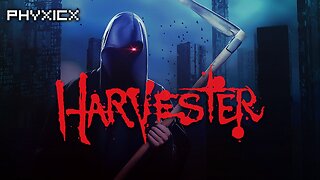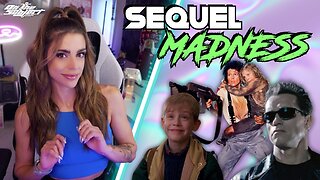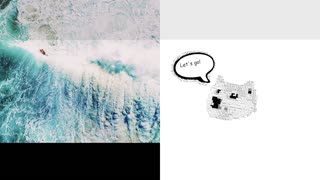Premium Only Content

Folk Blues Rock Country Soft Rock And Others Megamix VDO
It's a mix between so different styles of music through ages and harmony including its lyrics, titles and year of appearance.
Hope you like it, if so then hit a like. Thank you.
Tracklist :
1) Chris Rea '' Nothing To Fear '' ( First appear 1992 )
Written in response to Islamophobia, Rea said :
It's a song about a European guy welcoming Muslims, and the gist of the story is that if you show us we have nothing to fear, there's gonna be no problem. And it's asking them to show a sign of peace. Once we all had to be frightened of the Russians, then we had to be frightened of the Chinese, and at the moment, for the last year, it's been this coming of the Muslims thing.
2) Daniel Castro '' I'll Play The Blues For You '' ( First appear 1999 )
I'll Play The Blues For You is the seventh studio album by American blues guitarist Albert King released in 1972.
"I'll Play the Blues for You" is a classic blues song written by Jerry Beach. It was made popular by Albert King though, one of the most influential blues guitarists and singers of all time. King’s recording of it was released in 1972 as the title track from his iconic album "I'll Play the Blues for You."
The song’s lyrics talk about a musician promising to play the blues for someone who's feeling down or going through a tough time. The track was recorded at Stax Studios in Memphis, Tennessee, known for its rich history in producing soul and blues music. Stax was an important recording studio in the 1960s and 1970s, contributing to the creation of many iconic soul and blues tracks.
"I'll Play the Blues for You" received great reviews when released and has since become a blues standard. Albert King's soulful vocals and electrifying guitar work, combined with the song's heartfelt lyrics, resonated with audiences and critics alike.
The song has been covered by numerous artists over the years such as Daniel Castro who grew up in Los Angeles and added it to his first album No Surrender.
3) America '' A Horse With No Name '' ( First appear 1971 )
Originally called "Desert Song", "Horse" was written while the band was staying at the home of musician Arthur Brown, near Puddletown, Dorset, England. The first two demos were recorded there by Jeff Dexter and Dennis Elliott, which were intended to capture the sensation of the hot, dry desert that had been depicted in a Salvador Dalí painting, and in a picture by M. C. Escher which featured a horse. Writer Dewey Bunnell also says he remembered his childhood travels through the Arizona and New Mexico desert when his family lived at Vandenberg Air Force Base. The lyrics include the lines "I've been to the desert on a horse with no name. It felt good to be out of the rain." Bunnell has explained that "A Horse with No Name" was "a metaphor for a vehicle to get away from life's confusion into a quiet, peaceful place".
4) Playing For Change '' The Dock Of The Bay '' ( First appear 2018 )
"(Sittin' On) The Dock of the Bay" is a song co-written by the soul singer Otis Redding and the guitarist Steve Cropper. Redding recorded it twice in 1967, including just three days before his death in a plane crash on December 10, 1967. It was released on Stax Records' Volt label in 1968, becoming the first posthumous #1 single in the US. Redding started writing the lyrics in August 1967 while staying on a rented houseboat in Sausalito, California. He completed the song in Memphis with Cropper, a Stax producer and the guitarist for Booker T. & the M.G.'s. It features whistling and sounds of waves crashing on a shore.
The song was covered many times including this version from Playing For Change in 2018 which is a multimedia music project, featuring musicians and singers from across the globe, co-founded in 2002 by Mark Johnson and Whitney Kroenke. Playing For Change also created in 2007 a separate non-profit organization called the Playing For Change Foundation, which builds music and art schools for children around the world.
5) Alan Jackson '' Hard Hat and a Hammer" ( First appear 2010 )
"Hard Hat and a Hammer" is a song which praises blue collar workers in general for their hard work. The song includes the sound of Jackson striking an anvil owned by his father, who died in 2000. The video features miners from Stilhouse mining in Benham, Kentucky, workers from the Bayou La Batre, Alabama shipyard, and railroad workers from TRR Railroad in Mobile, Alabama. It was also filmed at paper mills, foundries, taxi stands, Nashville’s Fire Station #16 and Bar-B-Cutie and more than a dozen other locations.
6) Chris rea '' Auberge '' ( First appear 1989 )
Upon release, Music & Media wrote, "Rea at his best: the perfect combination of Dire Straits-framed vocals and Ry Cooder-styled slide guitar. The type of song to play loud during driving. Traffic will be much nicer the next weeks."Andy Stout of Sounds described the song as "good, honest rock à la Bob 'Excitement' Harris". In the US, Billboard described the song as a "dreamy blues-induced rocker", with "dark, Morrison-esque vocal delivery, "rockabilly guitar backdrop", "psychedelic organ vibes" and "lighthearted horn riffs". In a review of the album of the same name, Johnny Loftus of AllMusic wrote, "The rousing title track and its accompanying set piece "Set Me Free" move from searching, tentative guitar noodlings into full-blown epics, with bluesy bottom end, blustering horns, backup singers, and Rea's own grainy vocal rumble."
7) Pink Floyd '' Another Brick In The Wall '' ( First appear 1979 )
It's a protest song against corporal punishment and rigid and abusive schooling, features a children's choir. At the suggestion of the producer, Bob Ezrin, Pink Floyd incorporated elements of disco. The three parts of "Another Brick in the Wall" appear on Pink Floyd's 1979 rock opera album The Wall. They are essentially one verse each, although Part 2 sees its own verse sung twice: once by Floyd members, and the second time by the guest choir along with Waters and Gilmour. During "Part 1", the protagonist, Pink, begins building a metaphorical wall around himself following the death of his father. In "Part 2", traumas involving his overprotective mother and abusive schoolteachers become bricks in the wall. Following a violent breakdown in "Part 3", Pink dismisses everyone he knows as "just bricks in the wall". Bassist Roger Waters wrote "Part 2" as a protest against rigid schooling, particularly boarding schools. "Another Brick in the Wall" appears in the film based on the album. In the "Part 2" sequence, children enter a school and march in unison through a meat grinder, becoming "putty-faced" clones, before rioting and burning down the school.
8) Dire Straits '' On Every Street '' ( First appear 1991 )
On Every Street was released more than six years after the band's previous album, Brothers in Arms. On Every Street reached number 12 in the United States and number one in the United Kingdom and numerous European countries. The album was produced by Mark Knopfler and Dire Straits. By this time, the band consisted of Knopfler, John Illsley, Alan Clark and Guy Fletcher, and the album features session musicians including Chris White, Paul Franklin, Phil Palmer, Danny Cummings and American drummer Jeff Porcaro from Toto, who was asked to play the band's subsequent world tour, although he declined because of other commitments, both with Toto and as a studio musician. Dire Straits promoted the album with a 14-month world tour which comprised 216 shows in Europe, North America, and Australia, sold 7.1 million tickets, and lasted from August 1991 to October 1992. This was documented in the group's second live album, On the Night, which was recorded in May 1992 at Les Arenes in Nîmes, France, and at Feijenoord Stadion in Rotterdam, The Netherlands, and was released in May 1993. Dire Straits disbanded permanently in 1995, after which Mark Knopfler pursued a solo career. The album was remastered and reissued with the rest of the Dire Straits catalogue in 1996 for most of the world, except for the United States, where it was reissued on 19 September 2000.
9) Tracy Chapman '' Crossroads '' ( First appear 1989 )
On its release as a single, Tim Southwell of Record Mirror wrote, "'Crossroads' sees Tracy in familiar sombre mood, reflecting on life's struggles and the pain of it all. It may not be frothy but Chapman's cool vibes are always welcome". Sian Pattenden of Smash Hits described the song as "very much the kind of folksy, sombre song you'd expect from Tracy". She added, "If you liked "Fast Car" then you'll like this because it's jolly similar". In a review of Crossroads, Fred Goodman of Rolling Stone noted the song's "rich arrangement and heartfelt delivery" and added, "'Crossroads' breaks little new ground for Chapman musically, but its subtly shaded percussion, pizzicato violin and lilting accordion give new muscle to Chapman's previously bareboned presentation". Steve Morse of The Boston Globe felt the song "opens the album in a startling confessional manner". Parry Gettelman of The Orlando Sentinel considered the song to "proclaim [Chapman's] independence from materialism and money-changers who beset her". Brian Springer of The Daily Tar Heel wrote, "The title track adds the only new lyrical wrinkle [on the album], with Chapman making the usual star complaint of having to deal with all the attention. Accordion and violin pizzicato give this song a slightly different flavor than the previous album".
10) Tony Joe White '' Ain't Going Down This Time '' ( First appear 1991 )
Closer to the Truth is a 1991 album by American singer-songwriter Tony Joe White where appear the song ''Ain't Going Down This Time''. The album marked White's return to recording, after years working solely as a songwriter. The songs "Steamy Windows" and "Undercover Agent for the Blues" were originally written for Tina Turner, and were previously recorded by her for her album Foreign Affair, featuring White on guitar. The Courier-Mail wrote that the album "has several stand-out tracks including 'Tunica Motel,' 'The Other Side,' 'Cool Town Woman' and 'Bare Necessities".
11) Mark Knopfler '' What It Is '' ( First appear 2000 )
The song's lyrics pay homage to the city of Edinburgh, Scotland, making reference to Edinburgh Castle, the Stone of Scone and Canongate Tolbooth.
12) Mark Knopfler '' Postcards From Paraguay '' ( First appear 2004 )
The song was recorded in Shangri-La Studios and appear in the fourth album of Knopfler. In March 2003, Knopfler was involved in a motorbike crash in Grosvenor Road, Belgravia, and suffered a broken collarbone, broken shoulder blade, and seven broken ribs. The planned Ragpicker's Dream Tour was subsequently cancelled. Knopfler spent seven months away from the guitar in physiotherapy, but eventually recovered and was able to return to the studio in 2004 for his fourth album and supporting tour the following year. Mark Knopfler said about Postcards From Paraguay : I imagined some errant individual doing a runner with the stolen loot. Someone suggested to me recently that the album is partly about the honest toiler versus those who thrive on ill-gotten gains. Perhaps the subject has been more on my mind in these days of corporate crime.
13) Bob Marley '' Could You Be Loved '' ( First appear 1980 )
Written in 1979 on an aeroplane while The Wailers were experimenting on guitar, "Could You Be Loved" has been described as a reggae and disco fusion. In the middle of the song, background singers quote a verse from Bob Marley's first single "Judge Not": "The road of life is rocky; And you may stumble too. So while you point your fingers, someone else is judging you". Instruments used on the original record of this song are guitars, bass, drums, acoustic piano, the Hohner Clavinet and an organ, as well as the Brazilian cuíca.
14) Phil Collins '' In The Air Tonight '' ( First appear 1981 )
Collins wrote the song amid the grief he felt after divorcing his first wife Andrea Bertorelli in 1980. In a 2016 interview, Collins said of the song's lyrics: "I wrote the lyrics spontaneously. I'm not quite sure what the song is about, but there's a lot of anger, a lot of despair and a lot of frustration". In a 1997 BBC Radio 2 documentary, the singer revealed that the divorce contributed to his 1979 hiatus from the band Genesis, until they regrouped in October of that year to record the album Duke. Collins remembered playing the song to Mike Rutherford and Tony Banks but he felt it was too simple for the group. Collins has described obtaining the drum machine specifically to deal with personal issues relating to his divorce through songwriting, telling Mix magazine: "I had to start writing some of this music that was inside me". He improvised the lyrics during a songwriting session in the studio: "I was just fooling around. I got these chords that I liked, so I turned the mic on and started singing. The lyrics you hear are what I wrote spontaneously. That frightens me a bit, but I'm quite proud of the fact that I sang 99.9 percent of those lyrics spontaneously". The original single version of "In the Air Tonight" features extra drums that play underneath the song until the signature drum crash (referred to by fans as the "magic break") appears. These were added at the suggestion of Atlantic Records head Ahmet Ertegun. In 2007, Collins wrote: Ahmet came down to the final mix in the cutting room in New York ... The drums don't come in until the end but Ahmet didn't know that at this point, because on the demo the drums hadn't come in at all; it was only drum machine all the way. And he was saying, "Where's the down beat, where's the backbeat?" I said, "The drums come in in a minute". "Yeah, you know that and I know that, but the kids don't know that; you've got to put the drums on earlier". So we added some drums to the mix and put it out as a single. Speaking about the song's rapid ascension in the music charts, Collins wrote the following in 2007: It was a surprise. The single came in at No. 36, I did Top of the Pops with Dave Lee Travis, and in one of the down moments he said, "This record is going to be a top three". I didn't believe him, because it had been made so haphazardly, but the next week, there it was at No. 3. And then Mark Chapman shot John Lennon and that was that. An urban legend has arisen about "In the Air Tonight", according to which the lyrics are based on a drowning incident in which someone who was close enough to save the victim did not help them, while Collins, who was too far away to help, looked on. Increasingly embellished variations on the legend emerged over time, with the stories often culminating in Collins singling out the guilty party while singing the song at a concert. Collins has denied all such stories; he commented on the legends about the song in a BBC World Service interview: I don't know what this song is about. When I was writing this I was going through a divorce. And the only thing I can say about it is that it's obviously in anger. It's the angry side, or the bitter side of a separation. So what makes it even more comical is when I hear these stories which started many years ago, particularly in America, of someone come up to me and say, "Did you really see someone drowning?" I said, "No, wrong". And then every time I go back to America the story gets Chinese whispers, it gets more and more elaborate. It's so frustrating, 'cause this is one song out of all the songs probably that I've ever written that I really don't know what it's about, you know? The urban legend was famously referenced by Eminem in a call-back in his 2000 chart-topping hit "Stan":
You know the song by Phil Collins, "In the Air of the Night" [sic]
About that guy who coulda saved that other guy from drownin'
But didn't, then Phil saw it all, then at a show he found him?
The music video (directed by Stuart Orme) animates the photograph of Collins's face from the cover of the Face Value album, slowly fading in through the introduction until it fills the screen, singing the first chorus. The video then cuts to Collins sitting in an empty room at night. Twice a spectral figure appears in the window, but only the second time does Collins get up to look at it, then is shown walking to the one door of the room. Collins's face returns for the second chorus. He is then shown leaving the room and entering a hallway full of doors. The first one is locked, then the second opens and Collins sees himself looking at the window again, only now the spectre has turned into his own reflection. The third door is locked, but as the fourth one opens, the drum break sounds and the viewer is returned to Collins's face again, this time in thermal coloring, which gradually reverts to black and white. His reflection from the window is briefly superimposed on the face, this time seemingly reflected in water. Collins recedes into the darkness as the song repeats and fades. In 1983 the music video was released on the home video Phil Collins available on VHS and LaserDisc which received a Grammy nomination for Best Video, Short Form.
15) Bruce Springsteen '' Streets Of Philadelphia '' ( First appear 1993 )
In early 1993, Philadelphia director Jonathan Demme asked Springsteen to write a song for his film, adding "I want it to play in the malls". Springsteen replied, "Well, I'm interested, so I'd like to come up with a song for you. If you give me some time, I'll see, but I can't promise". Springsteen recalled adding, "I'm not very good at scores". In late August 1993, following the conclusion of his 1992-93 world tour, Springsteen recorded a demo of his completed song at Thrill Hill, his home recording studio in Beverly Hills, California, including all the song's instrumentation. He mailed the tape to Demme, who later said, "my wife and I sat down and listened to it, and we were literally weeping by the end". Meanwhile, background vocals were added by Tommy Sims, who played bass on Springsteen's 1992-93 tour. Larry Flick from Billboard magazine wrote, "Springsteen's empathetic lyrics and performance zoom straight for the heart, traveling atop a slow and sturdy beat and pillowy synths. A powerful song with or without the image of the film to support it". Troy J. Augusto from Cash Box named it Pick of the Week, describing it as an "appropriately somber song," writing, "Written in the first person, this slow-moving ballad documents the struggle of a downtrodden and forgotten soul left to wander the dark streets, out of sight of an uncaring society. Like Hanks' character in the film, Springsteen's unfortunate draws on our sympathy, not because he asks for help but because he appears unable to help himself, an important distinction. One of The Boss’ best". Kent Zimmerman from the Gavin Report concluded, "Bruce Springsteen's custom-written theme is as scary a portrait of AIDS as you're likely to hear all year long. Combining the gruesome fears of urban abandonment coupled with the tragedy of a fatal disease in just one song is surely a miracle of subtlety". Robert Hilburn from the Los Angeles Times deemed it "a moving ballad about a man whose body is being destroyed by AIDS", and "a work that shows Springsteen, despite all the questions raised by changes in his life in recent years, can still write purposeful songs that connect on a deeply emotional level". He added, "Springsteen sings in a voice that expresses the helplessness and heartache of someone dying of AIDS as convincingly as Springsteen once conveyed the dreams and aspirations of youth". In his weekly UK chart commentary, James Masterton said, "However good it may be the brooding ballad is hardly classic Bruce and can be expected to shuttle rapidly out next week". A reviewer from Music & Media commented, "The man who used to walk upon E-Street, now roams the Philly lanes. This synth-dominated track from the OST Philadelphia revives the "etherealism" of Tunnel Of Love". Stephen Dalton from NME wrote, "The Boss fights through eerie ambient mists and prowls in a buried, snaking backbeat as he pleads for human warmth in a freezing world. It's a heartbreaker, surpassing most of Brucie's recent chest-beating in its soulful understatement". Neil Spencer from The Observer felt Springsteen's "sombre" "Streets of Philadelphia" "reflects a dark night of the soul as the disease takes hold". Pete Stanton of Smash Hits gave the song a score of four out of five, writing, "This is far gentler, far lovelier and far nicer than anything he's done for ages. Taken from the excellent film [...], this should see Bruce back in the charts". The accompanying music video for the song, directed by Jonathan Demme and his nephew Ted Demme in December 1993, begins by showing Springsteen walking along desolate city streets, followed by a bustling park and schoolyard, interspersed with footage from the film. After a quick shot of Rittenhouse Square, it ends with Springsteen walking along the Delaware River, with the Benjamin Franklin Bridge in the background. Tom Hanks is also visible as Andrew Beckett, the lead character he plays in the film, looking on as Springsteen begins the final verse. One newspaper review called it "the saddest track cut this decade". The vocal track for the video was recorded live with a hidden microphone, to a pre-recorded instrumental track. This technique, appropriate for emotionally intense songs for which conventional video lip-syncing would seem especially false, was used by John Mellencamp in parts of the video for his 1985 song "Rain on the Scarecrow", and by Springsteen himself in the video for his 1987 single "Brilliant Disguise", singing the song directly into the camera as he sits on the edge of his chair on a Sandy Hook, New Jersey sound stage.
16) Dire Straits '' Private Investigations '' ( First appear 1982 )
The song begins with a deep-pitched synthesizer orchestration (omitted from the 7" single edit), leading into a slow piano progression accompanying a classical guitar, followed by several spoken verses. The single edit removes the opening synthesisers, beginning with acoustic guitar. After the verses, the song opens into a slow, bass-driven beat, with strident electric guitar chords at the end, before the gradual diminuendo featuring extended interplay between Mark Knopfler's acoustic guitar and marimba played by Mike Mainieri. On the Sultans of Swing: The Very Best of Dire Straits DVD, Mark Knopfler said this about the song: "It's just about the Private Investigations... "What have you got at the end of the day" – Nothing more than you started out with..." It is said the song was inspired by author Raymond Chandler.
17) Mark Knopfler '' Done With Bonaparte '' ( First appear 1996 )
"Done With Bonaparte" appears on Golden Heart (1996), Mark Knopfler’s debut solo album, and stands as one of its most historically evocative tracks. Written from the perspective of a weary Napoleonic soldier, the song blends folk instrumentation with lyrical storytelling to reflect on the brutal cost of war and the disillusionment that follows. It opens with stark imagery: "We’ve paid in hell since Moscow burned / As Cossacks tear us piece by piece," immediately placing the listener in the aftermath of Napoleon’s failed Russian campaign. The narrator, once a loyal soldier, now longs for peace and home, declaring, "I’m done with Bonaparte". Musically, the track is steeped in traditional textures—featuring mandolin, fiddle, and accordion—that echo the folk traditions of 19th-century Europe. Knopfler’s restrained vocal delivery and fingerpicked guitar lend the song a sense of quiet resignation, underscoring the emotional weight of its subject. "Done With Bonaparte" is more than a historical vignette—it’s a meditation on loyalty, loss, and the human cost of ambition. It showcases Knopfler’s gift for inhabiting characters and eras with empathy and precision, all while crafting melodies that feel timeless.
18) Mark Knopfler '' Why Aye Man '' ( First appear 2002 )
"Why Aye Man" is the opening track from Mark's 2002 album, The Ragpicker's Dream. The song was also used in the closing credits of the BBC series "Auf Wiedersehen Pet". The Ragpicker's Dream Mark Knopfler's third solo studio album is a collection of songs written from the point of view of poor but dignified itinerant men, struggling to get by in life, often enjoying small triumphs. Knopfler gives a folk imprint to the whole album without relying too heavily on the acoustic guitar. The album contains numerous other references to North East England, including the village of Tow Law on "Hill Farmer's Blues". In his review for AllMusic, Hal Horowitz gave the album three out of five stars, calling the album "a pleasant, classy, often inspired effort whose unassuming charms are best appreciated after repeated listenings". Horowitz continued: The memorable riffage that fueled Dire Straits' most radio-friendly material has been discarded for a more pastoral approach, making this a perfect album for a rainy Sunday morning. Like his Notting Hillbillies side project, it isn't entirely unplugged, yet there is an emphasis on acoustic accompaniment to its predominantly ballad slant. Instead of leaving space for traditional soloing, Knopfler weaves his snake-like guitar between the words. This infuses a tense, edgy quality in even the most bucolic tracks. Horowitz acknowledges Knopfler's versatility and breadth of music on the album: the atmospherics of "Hill Farmer's Blues" and "Fare Thee Well Northumberland", the unaccompanied folk/blues of "Marbletown", the "shuffling groove" on the spooky "You Don't Know You're Born", the mid-tempo "Coyote", the authentic honky tonk swing of "Daddy's Gone to Knoxville", and Roger Milleresque "Quality Shoe". Horowitz singles out the title track, which he describes as "an homage to the American roots music he's always admired".
-
 LIVE
LIVE
Flyover Conservatives
21 hours agoYour Home Just Became a Healing Room — The Truth About Red Light & Med Bed - Jonathan Otto | FOC Show
432 watching -
 2:11:35
2:11:35
Mally_Mouse
4 days ago🎮 Throwback Thursday! Let's Play: Kingdom Hearts 1 pt. 2
5.15K1 -
 3:00:37
3:00:37
Barry Cunningham
5 hours agoBREAKING NEWS: LETITIA JAMES INDICTED FOR MORTGAGE FRAUD!!! LIBTARD TEARS ARE FLOWING!
29.1K20 -
 1:17:42
1:17:42
Glenn Greenwald
5 hours agoUS/Venezuela Escalations: Revisiting Key Developments and the Push for Regime Change | SYSTEM UPDATE SPECIAL
90.7K139 -
 LIVE
LIVE
ProvenTactics
2 hours agoFPS Shooter Games
64 watching -
 LIVE
LIVE
Phyxicx
2 hours agoHarvester - The Funniest, Most Deranged 90s Game Ever | 18+ | 10/9/2025
63 watching -
 LIVE
LIVE
LFA TV
23 hours agoLIVE & BREAKING NEWS! | THURSDAY 10/9/25
502 watching -
 LIVE
LIVE
megimu32
2 hours agoON THE SUBJECT: Sequels That Slapped! 🎬
74 watching -
 2:02:29
2:02:29
tminnzy
3 hours agoThe Final Runn || !stakeus || !stake
922 -
 6:00:05
6:00:05
Wahzdee
6 hours agoBF6 Countdown Stream – What to Play Till Launch? Let’s Talk Battlefield
9522